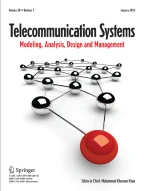Abstract
In this paper, we propose a novel technique to reduce the crest factor (CF) in orthogonal frequency division multiplexing systems. It consists of two inverse fast Fourier transform (IFFT) blocks, the input symbols of the first IFFT are the mapped symbols, whereas the input symbols of the second IFFT are the summations of the absolute value of the real part of the outer signal constellation points and zero symbols. First, the output of the two IFFT blocks is partitioned into four subblocks, which are subsequently used to rearrange the subblocks with padding zeros in a specific manner. Then, a new optimization scheme is introduced, in which only a single two-phase sequence and four iterations need to be applied. Numerical analysis shows that the proposed hybrid technique achieves better CF reduction performance with significantly lower complexity and better bit error rate performance than the existing scrambling (multiplicative) and additive CF techniques.
Similar content being viewed by others
Explore related subjects
Discover the latest articles, news and stories from top researchers in related subjects.References
Rahmatallah, Y., & Mohan, S. (2013). Peak-to-average power ratio reduction in OFDM systems: A survey and taxonomy. IEEE Communications Surveys and Tutorials, 15(4), 1567–1592.
Varahram, P., & Ali, B. M. (2011). Partial transmit sequence scheme with new phase sequence for PAPR reduction in OFDM systems. IEEE Transactions on Consumer Electronics, 57(2), 366–371.
Müller, S. H., & Huber, J. B. (1997). OFDM with reduced peak-to-average power ratio by optimum combination of partial transmit sequences. Electronics Letters, 33(5), 368–369.
Al-Hussaini, K., Ali, B. M., Varahram, P., Hashim, S., & Farrell, R. (2016). A new subblocks interleaving PTS Technique with minimum processing time for PAPR reduction in OFDM systems. Electronics Letters, 1(1), 21. doi:10.1049/joe.2016.0074.
Jiang, T., & Wu, Y. (2008). An overview: Peak-to-average power ratio reduction techniques for ofdm signals. Electronics Letters, 54(2), 257268.
Al-Hussaini, K. and Ali, B. M. and Varahram, P. and Hashim, S.K. Al-Hussaini, B. M. Ali, P. Varahram, S. Hashim (2016). A novel low complexity high efficiency hybrid PAPR reduction for OFDM systems. 2015 IEEE 12th Malaysia International Conference on Communications (MICC) (MICC’15), p. 345350.
Sabbir, A., & Makoto, K. (2013). Interleaving effects on BER fairness and PAPR in OFDMA System. IEEE Communications Letters, 52, 18393.
Mukunthan, P., & Dananjayan, P. (2014). Modified PTS with Interleaving for PAPR Reduction of OFDM Signal with QPSK Subblock. Electronics Letters, 3, 1–8.
Han, S. H., & Lee, J. H. (2005). An overview of peak-to-average power ratio reduction techniques for multicarrier transmission. Electronics Letters, 12(2), 56–65.
Goldsmith, A. (2005). Wireless communications, chap. 12. Cambridge: Cambridge University Press.
Alavi, A., Tellambura, C., & Fair, I. (2005). PAPR reduction of OFDM signals using partial transmit sequence: An optimal approach using sphere decoding. IEEE Communications Letters, 9(11), 982–984.
Taspinar, N., Kalinli, A., & Yildirim, M. (2011). Partial transmit sequences for PAPR reduction using parallel tabu search algorithm in OFDM systems. IEEE Communications Letters, 15(9), 974–976.
Wang, Y., Chen, W., & Tellambura, C. (2010). A PAPR reduction method based on artificial bee colony algorithm for OFDM signals. IEEE Communications Letters, 9(10), 2994–2999.
Cho, Y., No, J., & Shin, D. (2012). A new low-complexity PTS scheme based on successive local search using sequences. IEEE Communications Letters, 16(9), 1470–1473.
Li, H., Jiang, T., & Zhou, Y. (2011). An improved tone reservation scheme with fast convergence for papr reduction in ofdm systems. IEEE Communications Letters, 57(4), 902906.
Jiang, T., Ni, C., Xu, C., & Qi, Q. (2014). Curve fitting based tone reservation method with low complexity for papr reduction in ofdm systems. IEEE Communications Letters, 18(5), 805808.
Wang, Y., Chen, W., & Tellambura, C. (2012). Genetic algorithm based nearly optimal peak reduction tone set selection for adaptive amplitude clipping papr reduction. IEEE Communications Letters, 58(3), 462471.
Proakis, J. G., & Masoud, S. (2008). Digital Communications 5/E. New York: McGraw-Hill.
Krongold, B. S., & Jones, D. (2004). An active-set approach for ofdm par reduction via tone reservation. IEEE Communications Letters, 52(2), 495509.
Krongold, B. S., & Jones, D. (2003). Par reduction in ofdm via active constellation extension. In 2003 IEEE international conference on acoustics, speech, and signal processing (ICASSP 03) , Vol. 4, 52, p.IV5258.
Acknowledgments
This work was supported by Universiti Putra Malaysia under the Prototype Development Research Grant Scheme (PRGS) of the Ministry of Higher Education, Malaysia. (No. 5528700).
Author information
Authors and Affiliations
Corresponding author
Rights and permissions
About this article
Cite this article
Al-Hussaini, K., Ali, B.M., Varahram, P. et al. A low complexity high efficiency hybrid multiplicative-additive crest factor reduction for OFDM systems. Telecommun Syst 65, 297–307 (2017). https://doi.org/10.1007/s11235-016-0231-x
Published:
Issue Date:
DOI: https://doi.org/10.1007/s11235-016-0231-x
